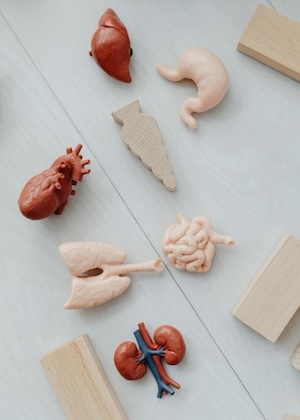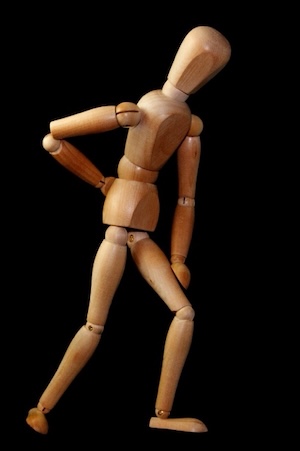Coping with “The Crawlies” on Hemodialysis

A couple of weeks ago, I was tagged in a post on the Home Dialysis Central Facebook Group post, because one of our members was struggling to get through treatment at home, especially during the last hour. This individual (I’ll call him Z) described intently watching the clock tick down on the machine, feeling fidgety, and experiencing surges in anxiety as time crawled by. This happened repeatedly. Even though Z wanted to do longer and more gentle treatments, he was so physically and psychologically distressed that these feelings became a barrier to completing regular-length treatments, and extended treatments felt like an impossible reach.
I read the post and thought, “Oh. The crawlies.”
The Crawlies are Common

There is no doubt in my mind that “the crawlies” are real, and they’re common. However, I am not aware of a professional term for this shared experience. I think it’s dismissed more than it’s addressed. I have had “the crawlies” described to me as:
An uncomfortable uneasiness that sets in during the last quarter of a treatment
A skin-crawling restlessness
An overwhelming urge to jump out of one’s body and run off screaming into the void
A clock-obsessed, antsy, fidgety, maddening type of anxiety
The crawlies are often accompanied by feelings of being tethered or trapped, which are quite literal and valid in the context of dialysis. Thinking back to when I worked in-center, I am pretty certain I witnessed “the crawlies” on a daily basis in some form or another. Some patients asked to come off early frequently because of it. They were encouraged to stay.
Those who couldn’t white-knuckle the chair and grit their teeth until the machine alarmed to announce the end of treatment were handed an AMA (Against Medical Advice) form to sign. This is a necessary document when you need to CYA (I’ll let you look up that acronym) against possible lawsuits in medical situations, but what’s on that form?

Well, “Death” is always there, listed very frankly as a potential complication of shortened treatments. While that is true, it’s not the best way to approach someone in distress.
Labels Have Consequences
An AMA form serves a legal purpose and also sends a message to patients, payers, and other interested parties who can access a medical record. Patients who leave AMA are often labeled “non-compliant”, and especially in ESKD, the label sticks and can be extremely damaging: it can disqualify a person from a transplant listing or a home dialysis referral, and both of those are the difference between life and death for many.

I question whether it’s fair to call someone who is suffering “non-compliant” if the only relief the person can get is to stop a treatment early. Perhaps “the crawlies” are a combination of symptoms, physiological responses to the treatment, and/or a psychosocial crisis.
Are we really listening to patients about the crawlies? Are we, as an industry, doing anything about it besides asking patients to endure more? I don’t think we are, or we would have a better term for this type of distress than the one I came up with.
Possible Treatment Related Causes
We know that removing too much fluid in too short a time is dangerous on hemodialysis. That is an established fact. High ultrafiltration rates (UFRs) cause systemic damage by inducing hypovolemia and hypotension that deprive every cell of essential blood and oxygen. We call this “stunning” and it kills people on dialysis.
Rapid electrolyte shifts occur during hemodialysis, and the less dialysis someone gets, the more rapid the shifts are…and the worse a person feels as a result of the treatment. These changes precipitate a vicious cycle in the setting of missing, skipped, or shortened treatments.
We know that rapid shifts and imbalances in electrolytes are associated with cardiac complications—like arrhythmias, including arrest.

But wait…cardiac symptoms can mimic anxiety!
We don’t know necessarily know the difference between a person experiencing an “impending sense of doom” due to anxious “crawlies” and one whose nervous system is sending warning signals right before a crash. It is not fair to hand an AMA form to someone who is responding to a physiological shift and trying to avoid harm.
Environmental Causes

I’d like to propose a small exercise in empathy for anyone reading this post who has never had the misfortune of being a dialysis patient.
Imagine having to sit in an uncomfortable economy airplane seat for the duration of two full-length movies. There is no WiFi, and instead of in-flight entertainment, you only get daytime TV. Also, there will be no snack or beverage service.
Due to turbulence, you are unable to get up and walk around at all. And, this plane you are stuck on is bustling with activity: there is bright florescent lighting and alarms are constantly blaring. There are a lot of things going on and a lot of other people in the other seats. It smells of bleach and vinegar. Your eyes burn a little.
After a few hours, you’re cold. Tired. Hungry. You feel drained, headachy, and kind-of nauseated. You might be starting to cramp, maybe not; you can’t tell yet. You feel terrible, but are told you have to stay. There is no way off the flight. And, you have to come back in 2 days and do it all over again, and again, and again…
Does that sound like a good deal to you? Is that a manageable expectation for your life? Can you appreciate how all of that can be psychologically daunting? “The crawlies” seem to me to be a fairly reasonable response to the sorts of situations we regularly put patients in.
It’s time for us to stop expecting patients to be okay with this. They are not immune from feeling stressed. I’m not okay all the time, either. Are you? Is anyone?
Physical Discomfort
It’s not normal, comfortable, or healthy for anyone to sit for a long time without shifting or stretching. However, it can be excruciatingly painful for people with chronic pain conditions. I have personally had several patients who chose to stop dialysis completely because of arthritis pain and declining functional mobility. Joint pain can be significant, and most dialysis centers only have Tylenol to offer patients for pain that is exacerbated by having to sit still in an uncomfortable chair for hours at a time.
Also, many patients have needles in one arm. Can you keep your arm in one position for hours and not feel achy? Failing to address physical discomfort patients feel, especially towards the end of a treatment, is a form of torture. We can at least encourage them to bring their own pillows, foam cushions, and blankets for more comfortable positioning if the clinic cannot or does not supply them. At home, patients have much more control over their comfort.

Mental Health

As it turned out, Z in the Facebook group who had “the crawlies” at home had a diagnosed anxiety disorder. Lots of people do. Many people have panic disorders, depression, ADHD, agoraphobia, blood and injection phobias, OCD, autism—you name it, on dialysis. Mental health does not suddenly improve when kidneys fail; those issues still exist, yet the expectation seems to be that patients should be able to cope with an ongoing difficult situation without complaint.
When someone is feeling “the crawlies,” we may be mistaking a legitimate and expected psychological response as “non-compliance”. And, we treat people with known mental illness as if they have a personality flaw. It certainly looks as if we are punishing people for being human.
Autonomy and Trust
I once trained a patient for home HD who used to cut his in-center treatments short. He really couldn’t stand the clinic environment, which caused him a lot of stress. He used to jump up and demand to be taken off the machine every time he came in. During training, one of the first things I showed patients was how to get off the machine quickly and safely. While I was demonstrating, he looked at me and asked, “What would you do if I said I was done for the day and needed to come off treatment right now?”

I told him that I would stop treatment immediately if he asked. I’d put the machine into rinseback, return his blood, make sure he was hemodynamically stable, remove the needles, and offer him another treatment tomorrow to try again. My patient looked shocked. He said he didn’t believe me. I told him, “try me,” but he didn’t have to. He understood that I meant it. I gave him back some situational control and could tell that this meant a great deal to him.
Consent is Ongoing
When patients consent to dialysis, and sign the initial forms, they need to be informed that they can withdraw that consent at any time, even temporarily. This is not just a technical detail of medical consent, it’s a psychological lifeline for all patients that we must respect. To combat some of “the crawlies”, the message to patients needs to be: No one is being held against their will. You are not stuck. We are not forcing you.
Home HD vs. the Crawlies

One of the benefits of home dialysis is returning more situational control to patients than they would have in-center. Home patients can adjust the room temperature to their comfort levels. They can choose their lighting, pick out a comfortable chair, have snacks, and not worry about having to fart in mixed company. They have their TV and favorite blanket. They have their pets and can select whom they do (and don’t) want around. Clothing is optional. There is only one treatment in progress, and the patient can tailor that treatment to their physiological needs. I’ve had several patients get into gaming to pass time, reduce anxiety and distract their brains long enough to finish treatments. Those who are particularly affected by “the crawlies” might be much happier at home for these reasons.
Even with every modification possible, “the crawlies” can still happen at home. People who are informed about the benefits of longer time can still find themselves feeling stuck toward the end of treatment. As I mentioned, Z is already on home HD and actively managing an anxiety disorder, too.
The Toolbox
Instead of ignoring “the crawlies” and sending a message to patients that their distress doesn’t matter and they should just “get over it”, let’s teach people how to work through the moments and give them the tools to do so. Here are some tools that can help patients who have anxiety:

Therapy. Some patients deliberately schedule telehealth appointments for the last part of treatment. This can help pass the time while actively addressing the negative emotions as they occur.
Distraction. Patients can be encouraged to try gaming, movies, audiobooks, and podcasts.
Relaxation. There are apps and YouTube videos for guided meditation, stress relief, etc.
Environmental adjustments. Comfort items like aromatherapy, cushions, or a neck pillow can help.
Time “chunking”. Teach patients to have an hourly treatment game plan. For example: I will do [this] during the first hour, [that] for the second, [something else] for the third, [another thing] for the fourth, [a new thing] for the fifth, and [an old hobby] for the sixth, etc.
Better treatment. It seems counterintuitive to talk about increasing time when someone is climbing the walls, and no small challenge to convince someone that they could feel better with more of something they don’t want at all. But, if this issue is recurring and accompanied by BP drops or cramping, a treatment adjustment must be made. Lowering a UFR and slowing a BFR can make a big difference.
If we shift our view to think of “the crawlies” as a complication, the steps we take to prevent or treat it are medical interventions—not indulgences for needy patients. They are a care team responsibility.
Time Matters, Always
Shortening a treatment will bring momentary relief and stop “the crawlies”. But, over time, this approach sets a dangerous precedent that will make patients feel worse. Feeling punished and shamed by clinicians for a symptom they can’t control is not the way to approach this. Let’s stop assuming people are “non-compliant” or “difficult” for being in distress and offer empathy before we hand out AMA forms. Let’s give patients tools to cope with these feelings, and above all—let’s listen to and believe them.



Comments